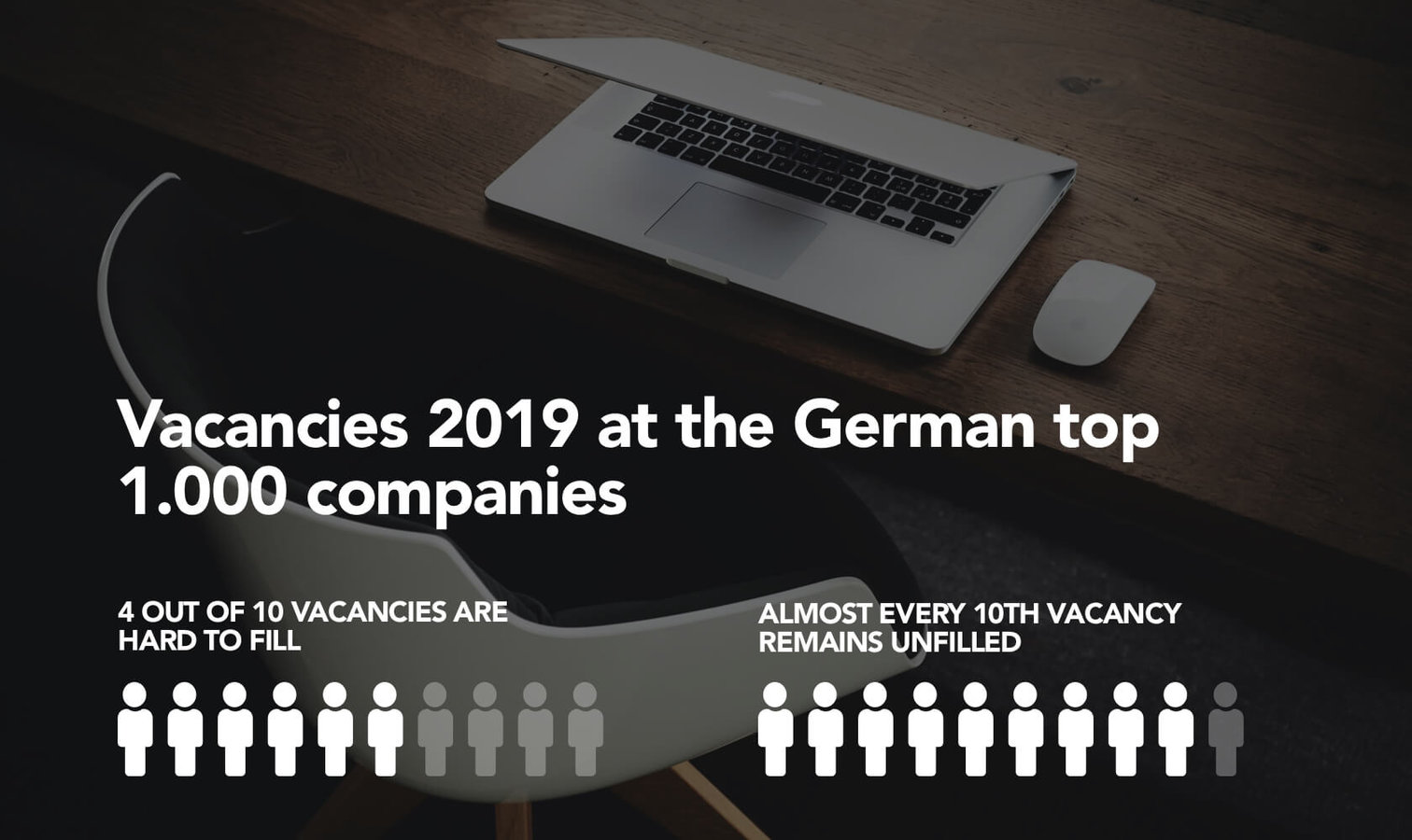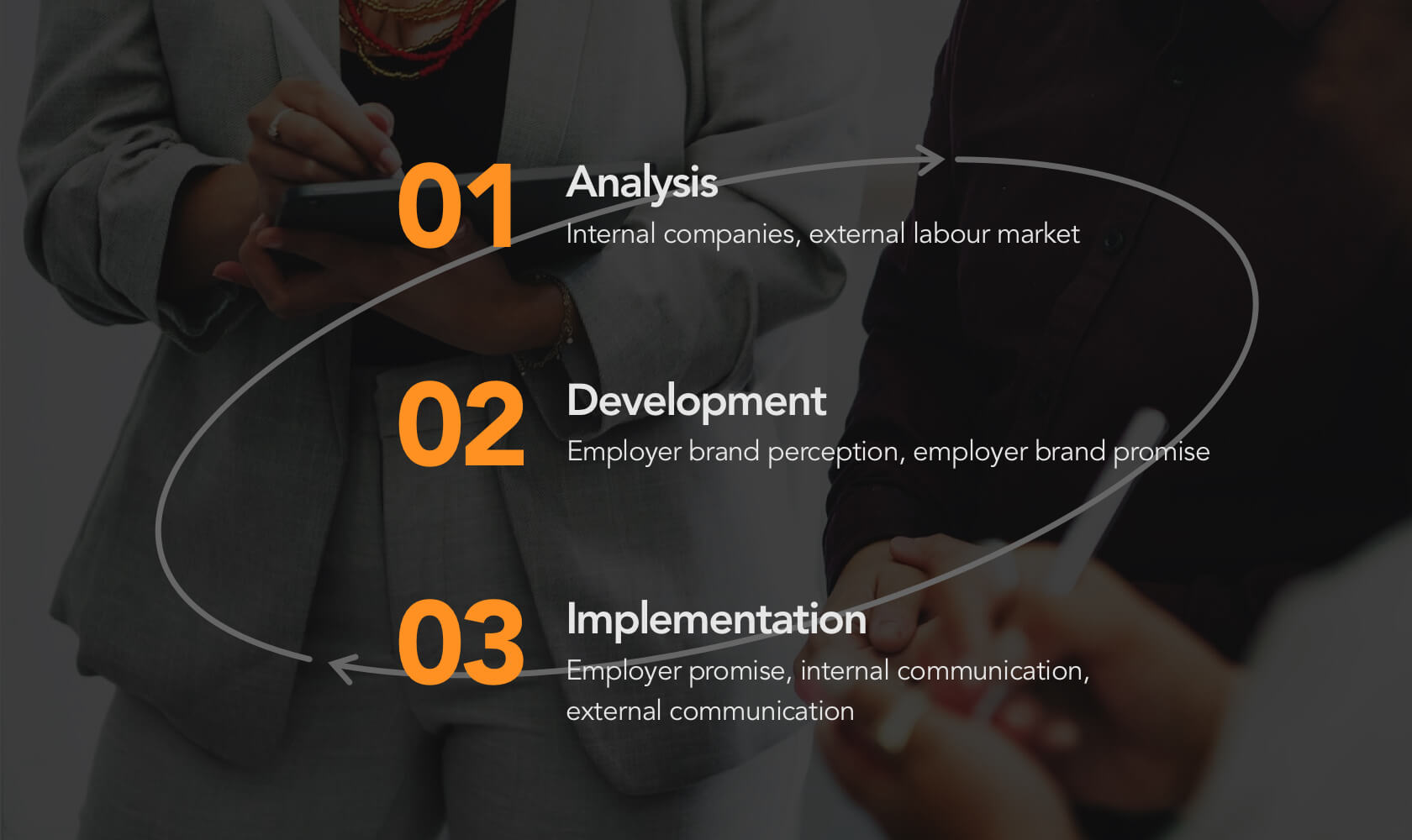
A company can only be as good as its employees. Especially in times of economic crisis - such as the Corona pandemic in 2020 - companies depend on loyal employees who feel committed to their company. But how do you get qualified people who stay?
Four out of ten vacancies at Germany's top 1,000 companies are difficult to fill, and almost one in ten positions remain unfilled. Compared to previous years, the number of vacancies is rising continuously. The peak of this trend is predicted for 2030. For the first time, the share of hard-to-fill vacancies among German IT companies will not be as high in 2019 as in previous years. However, it is still higher than among the top 1,000 companies. According to this, in 2019 42.9% of vacancies were difficult to fill and 14.1% were impossible to fill. (Study: Recruiting Trends 2020, Bewerbungspraxis 2020 des CHRIS).
For small and medium-sized companies, but also for large corporations, employer branding is the entrepreneurial measure to make themselves attractive for employees on the job market.
Employer branding is not a new term. Even if one could get the impression from the media that it is a relatively young trend topic, which has increasingly become a buzzword in the consciousness of agencies and companies since 2015. But what exactly is employer branding?
Employer branding is a corporate measure to position a company as an attractive employer in the labour market. In doing so, concepts from marketing, or more precisely branding, are applied. The company itself should thus become a positively associated brand for new and existing employees, but also for other stakeholders.
This concept already became known worldwide in 1996 with the publication of the professional article "The Employer Brand" by Tim Ambler and Simon Barrow in the Journal of Brand Management.
A company is perceived by employees and other stakeholders in a certain way. The embossing as an employer takes place at all times. Without employer branding, this development is left to its own unpredictable dynamics.
Targeted employer branding measures make it possible to actively control and shape this process. An opportunity that neither small, medium-sized nor large companies should miss. Because: The labour market is in a state of change.
Every tenth employee working for the top 1,000 companies will leave the organisation in the next few years. New workers are highly competitive. One speaks of the "war for talents". The new generation of employees assesses the attractiveness of an employer according to their own criteria and is demanding when choosing a new job. They are generally more willing to change employers if they are dissatisfied.
Employer branding focuses attention on company values and corporate culture as important aspects. The company steps out of the shadow of mediocrity, sharpens its profile as an employer and shows what makes it unique for employees. The company distinguishes itself from the competition and attracts attention through strong positioning.

Employer branding is essential against the background of the current labour market situation. For demographic reasons, the generational change in companies is progressing continuously. The demands on modern recruiting and contemporary human resources management are increasing.
Companies must position themselves authentically with credible values and a sustainable corporate culture in order to appear attractive as an employer and set themselves apart from their competitors.
The corona pandemic with the accompanying hygiene and safety recommendations makes the application process, onboarding, but also the long-term commitment of employees to the company even more challenging. In addition, many employees are insecure due to the state of emergency and also judge their jobs according to how the economic crisis is dealt with strategically and communicatively.
The topics of work-life balance and mobile working have gained in importance. Accordingly, there are some challenges that companies have to face.
Employer branding has many positive aspects that provide added value for both the internal and external perception of employers.
5 top reasons for internal employer branding
The effects of employer branding within the company:
- Establishes and specifies the own employer brand in the company. Employees develop a better understanding of their own employer and are familiar with the company's targets. This enables them to support these goals consciously and become more involved.
- Signal to employees that they are important for the company and are valued. Productivity increases and thus the profitability of the entire company.
- Employee relations are improved among each other, thus promoting internal cooperation.
- Employee satisfaction and loyalty increase, which intensifies the bond with the company.
- There is less fluctuation, costs for new appointments are reduced and core competencies remain within the company.
5 top reasons for external employer branding
The effects of employer branding outside the company:
- Gives the employer a face to the outside world in a controlled and self-determined way. Employer branding makes the company tangible through consciously granted insights into the corporate and work culture. This makes companies stand out from their competitors and generates a sustainable competitive advantage even over large companies. This promotes the perception as a potentially valuable employer.
- Positive impact of the employer image, which increases the attractiveness for new employees.
- If it is clear to the outside world what a company stands for, suitable employees will apply. The quality and quantity of applicants increases. The recruitment effort decreases.
- Employees who feel comfortable recommend the company to others and become brand ambassadors. Positive ratings on work portals are on the rise. The company is increasingly recognised. It becomes a topic of conversation (word-of-mouth).
- The company image and awareness in the industry improves.
As outlined in the previous section, there are many good reasons for employer branding. The concrete benefits of employer branding can be derived directly from this.
What benefits does employer branding offer in summary?
Employer branding improves the perception of a company both internally and externally - in a self-determined way. It is up to the company to set its own priorities that make it stand out from the competition. Employer branding thus supports the recruitment of new employees and the retention of current employees in the company. As job satisfaction increases, so does productivity and commitment. This, in turn, reduces absence from work and the general fluctuation rate in the workforce and consequently reduces recruitment costs for new positions.
How does employer branding work?
Employer branding and corporate branding are basically similar in concept. However, objectives and target groups vary. While corporate branding focuses on the corporate brand in its entirety, employer branding focuses on the employer brand. Employer branding can be divided into three core phases, which should be repeated at regular intervals as part of strategic employer brand management.
The first step is a comprehensive analysis of your own company, the needs of your employees and the competitive situation.
In the internal analysis, the aim is to identify the current situation within the company and to identify the need for action. It is crucial that the company values and the internal culture are identified in the analysis. Do the ideas of the top management coincide with the perception of the employees? The first step is to look at the existing employee base. On the one hand, the perceived corporate culture and employer image are recorded in an employee survey. On the other hand, the needs of the employees will be determined - in other words: How satisfied are they and what is actually important to them? Are there differences depending on generational affiliation? Are there deficits?
In addition to these internal results, the findings of current studies on the external labour market should also be taken into account in the further process. They provide information about which criteria make employers particularly attractive in the eyes of potential applicants. Which strong competitors are also looking for skilled personnel in the industry? Which unique selling propositions (employer value proposition) can the company use to set itself apart from the competition?
The development of the employer brand is divided into two main phases:
1. Employer brand perception:
How should the company be perceived as an employer? How do you want to position it strategically?
2. Employer brand promise:
What does the company promise its employees? What responsibility does it take as an employer for its employees? Why should applicants want to work here of all places? At this point it is imperative to define core messages for which the company stands as an employer. In the next step, these core messages must be anchored at all points of contact in the Employee Journey as employer promises formulated in a way that is appropriate for the target group. The communication strategy aims to reach both new and existing employees. In future, the Employer Brand Promise will be an important part of the texts for job applications.
Tip: Define clear candidate profiles for job advertisements and present your company values. This is the only way to find employees who match your requirement profile.
The defined employer brand must be established in the company so that the values are implemented and lived. This is the only way to make employer branding look authentic. The procedure is divided into three main steps:
1. Implementation of the employer promise:
Creation or modification of suitable processes into which the employer brand promise can be integrated. Otherwise the project remains just an idea and is not lived. Adaptation of the methods and language rules for addressing potential employees offline and online.
2. Internal communication of the employer brand:
Employees need sufficient information and points of contact to internalise which company they work for. What are the values? Which corporate culture and atmosphere should determine the daily work routine? What conditions must be in place to ensure that these values are lived? Managers in particular should set a good example themselves.
3. External communication of the employer brand
Communicate the brand using press and public relations work, the company website, social media channels, rating portals and all other digital and analogue contact points. The career site or recruiting portal in particular should clearly communicate the employer brand.
Further information and references
If you would like to know more about employer branding, take a look at the following helpful studies and white papers on employer branding:
- Employer Branding 2020. Ausgewählte Ergebnisse der Recruiting Trends 2020, einer empirischen Unternehmens-Studien mit den Top-1.000- Unternehmen aus Deutschland sowie den Top-300-Unternehmen aus der IT und der Bewerbungspraxis 2020. Center of Human Resources Information System (CHRIS ist ein Forschungsprojekt der Otto-Friedrich-Universität Bamberg und der Friedrich-Alexander-Universität Erlangen-Nürnberg)
- Employer Brand Research 2020. Report Germany. Randstad
- Auf der Suche nach den richtigen Kandidaten? Schritt für Schritt zum erfolgreichen Employer Branding. Fraunhofer-Zentrum für Internationales Management und Wissensökonomie IMW.
